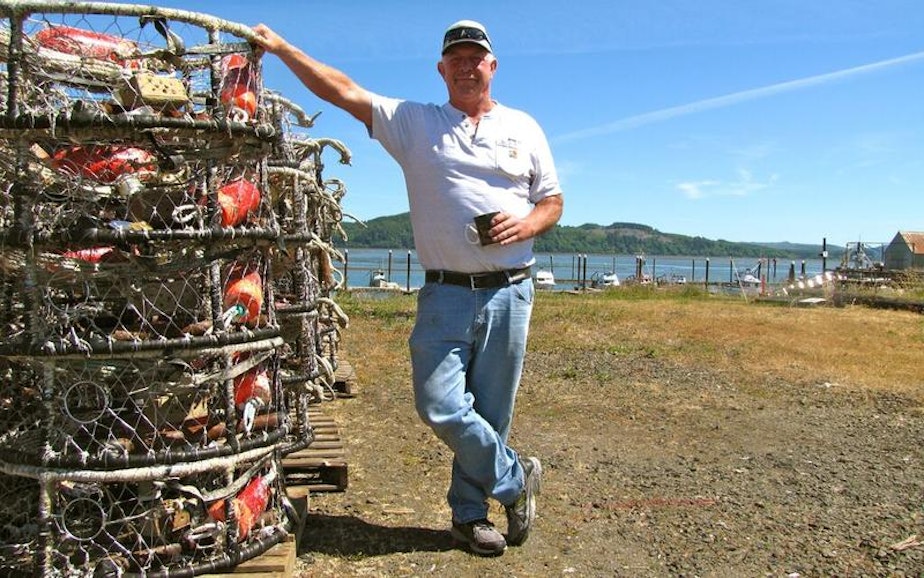Algae Bloom Hits Dungeness Crabbers Hard On Washington Coast

TOKELAND, Wash. – Tom Petersen’s 50-foot crab boat sits idly in the Port of Willapa Harbor, a tiny coastal inlet 40 or so miles north of the mouth of the Columbia River.
On a normal day in early summer, Petersen would be selling Dungeness crab to canneries, big-city buyers and even fresh off the back of his boat to locals and tourists.
And he’d make good money doing it. With crab selling at up to $10 per pound, Petersen could earn thousands of dollars a day.
But for the past few weeks, Petersen and all other commercial crabbers who fish this 38-mile stretch of Washington’s coast have been forced to pull up their crab pots. Unusually warm water and sunny weather this spring has contributed to a giant bloom of algae that releases a toxin known as domoic acid.
It gets into the food chain via filter feeders like razor clams that can then be eaten by crabs, marine mammals, birds and humans. Too much of the toxin can induce seizures, short-term memory loss and even death.
Commercial and recreational razor clamming, too, have been shut down in Oregon and parts of Washington, costing local economies hundreds of thousands of dollars.
The center of the algae bloom appears to be along Washington’s southern coast just north of the mouth of the Columbia River. The impacts on the multimillion-dollar commercial Dungeness crab fishery have been severe.
Peterson was out on his boat, the Gail Force, checking his pots when he heard the news that his fishing area was closed.
“It had been a really slow winter season, and it was just starting to shape up. And about noon that day I got the report that they were closing our season down,” Petersen says.
“I felt like throwing up. I was sick to my stomach.”
In Washington, commercial crabbing is worth roughly $84 million annually, according to the National Marine Fisheries Service. For the entire West Coast, the Dungeness crab fishery is worth upwards of $200 million a year.
“Dungeness crab is the single most valuable species fishery on the West Coast,” said Larry Thevik, vice president of the Washington Dungeness Crab Fisherman’s Association, and a crabber for 45 years. A sign advertising crab in the coastal Washington town of Tokeland still stands, even though a toxic algae bloom has forced the closure of crabbing along the state's south coast.
“If we have more of these episodes it’s going to be pretty devastating,” Thevik said.
But Thevik said that he does not oppose the state’s decision to close 38 miles of the Washington coast to Dungeness crab harvest. “We wouldn’t want to err on the wrong side of the public safety issue and have someone get ill and have that translate into a market crisis,” he said.
Commercial and recreational razor clam harvesting has been closed from Grays Harbor south to the Oregon-California line. Dan Ayres, the coastal shellfish manager for the Washington Department of Fish and Wildlife, said it was not easy to turn people away from the beaches in early May, but the risk was too high.
“Razor clams tend to bind the toxins in their fat tissue and they hang onto it for a long time,” Ayres said, adding that the concentrations of domoic acid found in some razor clam samples were more than 10 times above action levels.
Oysters and other filter feeders can also be contaminated, though they tend to pass the toxin through their systems more quickly than razor clams.
Ayres estimates that the lost revenue from the razor clam closure since May could total more than $9 million for Washington’s coastal communities. Commercial razor clam diggers are out roughly $250,000, he said.
“These are small business men who are living somewhat on the edge and it’s tough for them,” Ayres said.
Petersen stands next to hundreds of his crab pots, piled high and dry on the shore near the dock. Several other boats are tied up nearby, but there’s not a soul to be seen in the marina, which would normally be bustling this time of year, Petersen says.
He’s hoping that the bloom will subside and he and his crew can get back out on the water, but if toxin levels don’t go down, he could be looking at six months with no crabbing.
Petersen’s been doing this for 40 years. He has paid off his boat. He’ll get by, he says, but his two young crewmen are collecting unemployment.
“One of them is trying to make house payments. The other one’s got kids they’re trying to raise and they’re just all standing on the sidelines now,” he said, looking out over the quiet harbor.
“When I first started crabbing, I got on with this old sea dog and he told me, ‘Tom, you gotta really work hard. Every day you miss is a day you’re not going to make up.’”

